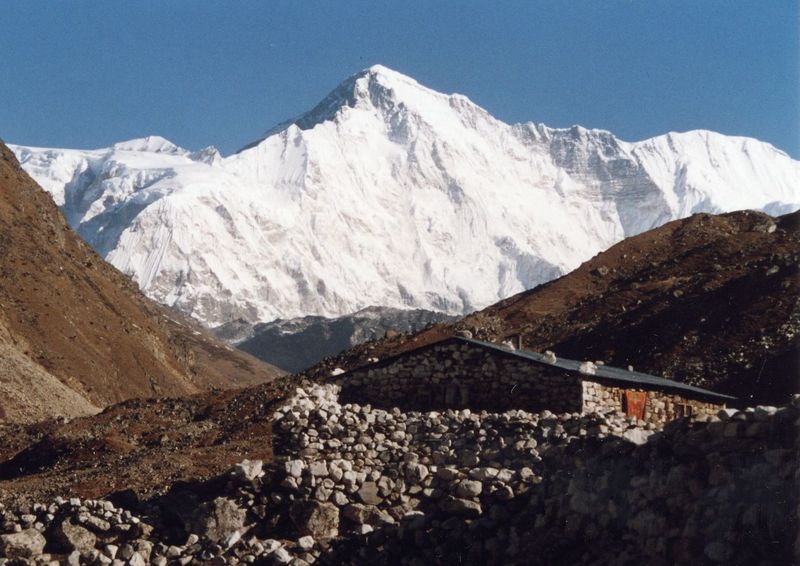|
 The
Himalayas are a mountain range in Asia, separating the Indian
subcontinent from the Tibetan Plateau. By extension, it is also the
name of the massive mountain system which includes the Himalaya
proper, the Karakoram, the Hindu Kush, and a host of minor ranges
extending from the Pamir Knot. The name is from Sanskrit himālaya, a
tatpurusa compound meaning "the abode of snow" (from hima "snow",
and ālaya "abode"). The
Himalayas are a mountain range in Asia, separating the Indian
subcontinent from the Tibetan Plateau. By extension, it is also the
name of the massive mountain system which includes the Himalaya
proper, the Karakoram, the Hindu Kush, and a host of minor ranges
extending from the Pamir Knot. The name is from Sanskrit himālaya, a
tatpurusa compound meaning "the abode of snow" (from hima "snow",
and ālaya "abode").
Together, the Himalaya mountain system is the planet's highest and
home to the world's highest peaks: the Eight-thousanders, including
Mount Everest. To comprehend the enormous scale of Himalayan peaks,
consider that Aconcagua, in the Andes, at 6,962 m, is the highest
peak outside the Himalaya, while the Himalayan system has over 100
separate mountains exceeding 7,200 meters.
The Himalayas stretch across six nations: Bhutan, China, India,
Nepal, Pakistan and Afghanistan. It is the source of three of the
world's major river systems, the Indus Basin, the Ganga-Brahmaputra
Basin and the Yangtze Basin. An estimated 750 million people live in
the watershed area of the Himalayan rivers, which also includes
Bangladesh.
Ecology
The flora and fauna of
the Himalayas varies with climate, rainfall, altitude, and soils.
The climate ranges from tropical at the base of the mountains to
permanent ice and snow at the highest elevations. The amount of
yearly rainfall increases from west to east along the front of the
range. This diversity of climate, altitude, rainfall and soil
conditions generates a variety of distinct plant and animal
communities, or ecoregions.
Lowland forests
On the Indo-Gangetic
plain at the base of the mountains, an alluvial plain drained by the
Indus and Ganges-Brahmaputra river systems, vegetation varies from
west to east with rainfall. The xeric Northwestern thorn scrub
forests occupy the plains of Pakistan and the Indian Punjab. Further
east lie the Upper Gangetic plains moist deciduous forests of Uttar
Pradesh and Lower Gangetic plains moist deciduous forests of Bihar
and West Bengal. These are monsoon forests, with drought-deciduous
trees that lose their leaves during the dry season. The moister
Brahmaputra Valley semi-evergreen forests occupy the plains of
Assam.
The Terai belt
Above the alluvial plain
lies the Terai strip, a seasonally marshy zone of sand and clay
soils. The Terai has higher rainfall than the plains, and the
downward-rushing rivers of the Himalaya slow down and spread out in
the flatter Terai zone, depositing fertile silt during the monsoon
season and receding in the dry season. The Terai has a high water
table, and the central part of the Terai belt is occupied by the
Terai-Duar savanna and grasslands, a mosaic of grasslands, savannas,
deciduous and evergreen forests that includes some of the world's
tallest grasslands. The grasslands of the Terai belt are home to the
Indian Rhinoceros (Rhinoceros unicornis).
The Bhabhar belt
Above the Terai belt is
an upland zone known as the Bhabhar, with porous and rocky soils,
made up of debris washed down from the higher ranges. The Bhabhar
and the lower Siwalik ranges have a subtropical climate. The
Himalayan subtropical pine forests occupy the western end of the
subtropical belt, with forests dominated by Chir Pine (Pinus
roxburghii). The central part of the range is home to the Himalayan
subtropical broadleaf forests, dominated by sal (Shorea robusta).
Montane forests
At the middle elevations
of the range, the subtropical forests yield to a belt of temperate
broadleaf and mixed forests, with the Western Himalayan broadleaf
forests at the western end of the range, and the Eastern Himalayan
broadleaf forests in Assam and Arunachal Pradesh. Above the
broadleaf forests are the Western and Eastern Himalayan subalpine
conifer forests.
Alpine shrub and
grasslands
Above the tree line are
the Northwestern, Western, and Eastern Himalayan alpine shrub and
meadows, which yield to tundra in the higher Himalayan range. The
alpine meadows are the summer habitat of the endangered Snow Leopard
(Uncia uncia). The highest reaches of the range are above the
permanent snow line. |

